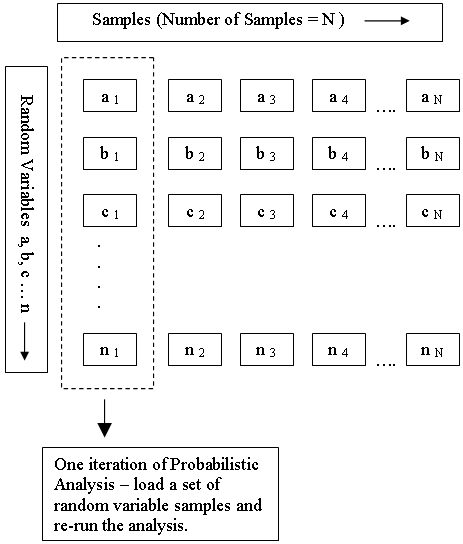Probabilistic Analysis Overview
In a traditional slope stability analysis, it is assumed that the values of all model input parameters are exactly known. Thus, for a given set of input, a single resulting value is calculated (e.g., a single safety factor, a single rock trajectory). This type of analysis can be referred to as a DETERMINISTIC analysis.
For most real-world rockfall problems, the values of many input parameters are NOT very well known; therefore, a PROBABILISTIC approach to the analysis of slope stability can be useful. In a probabilistic slope stability analysis, the user may assign statistical distributions to model input parameters.
Assigning a statistical distribution to one or more model input parameters allows the user to account for the degree of uncertainty in the value of the parameters. For every statistical simulation, input data samples are randomly generated, based on the user-defined statistical distributions. An adequate sample size would be required for a meaningful statistical or probabilistic analysis.
In statistical rockfall analysis, rock paths generated from a single point of origin may take on different trajectories and energies due to variability in the sampled input parameters. With many statistical simulations or rock path calculations, results are interpreted from the spatial distribution of many rockfall trajectories.
The general procedure for carrying out a Probabilistic Analysis with RocFall3, is as follows:
Project Settings
Select the Statistics tab in the Project Settings dialog. You may select the Sampling Method and the option to use a Custom Random Seed. If a Custom Random Seed is not specified, a default seed is used by the engine for the sampling of random variables, offering analysis repeatability.
Statistics Menu ( Defining Random Variables)
The options in the Statistics menu allow you to select model input parameters (e.g. material properties, seeder properties, etc.,) and define them as random variables. This is done by selecting a statistical distribution for each selected parameter (random variable) and entering the appropriate parameters for the distribution (distribution type, standard deviation, minimum and maximum values).
To carry out a Probabilistic Analysis, you must define at least ONE of your model input parameters as a Random Variable (see the Random Variables topic for more information), and simulate at least ONE rock path.
Number of Rock Paths
The number of rock paths or statistical simulations is defined in the Seeder Properties menu. For every Seeder Property, a Number of Rocks may be defined Over All Rock Groups or Per Rock Group.
Compute
After you have defined all desired Random Variables for the Probabilistic Analysis, select Compute.
How are the Random Variables used in the Analysis?
Each input parameter that is defined as a Random Variable is sampled according to its statistical distribution, the Sampling Method (Project Settings), and the Number of Samples (Number of Rocks). This generates N values of each Random Variable (where N = Number of Samples).
As shown in the following diagram, each iteration of the Probabilistic Analysis is carried out by loading a new set of random variable samples and re-running the analysis. This is repeated N times where N = Number of Samples.

Interpret
The results of the Probabilistic Analysis are viewed in the Results tab including the distribution of rockfall trajectories, heat maps of spatial distributions of rock endpoints, impact points, energies and heights, and options in the Interpret menu including endpoint distribution graphs and impact distributions on barriers.